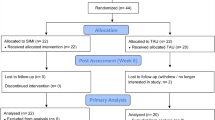Abstract
Children with autism rarely initiate social interactions with their peers. Currently available interventions have not increased autistic children' spontaneous initiations in natural settings without extensive teacher involvement. A “priming” strategy consisting of a low demand, high reinforcement session prior to the regular school activity was used to increase the spontaneous social initiations of 2 preschool age autistic boys to typically developing peers in a regular preschool classroom. Peers were also trained to independently respond to initiations. Implications for developing practical ways to improve autistic children's social functioning in regular school settings are discussed.
Similar content being viewed by others
References
Brady, M. P., Shores, R. E., Gunter, P., McEvoy, M. A., Fox, J. J., & White, C. (1984). Generalization of an adolescent's social interaction behavior via multiple peers in a classroom setting.Journal of the Association for the Severely Handicapped, 9, 278–286.
Charlop, M. H., Schreibman, L., & Thibodeau, M. G. (1985). Increasing spontaneous verbal responding in autistic children using a time delay procedure.Journal of Applied Behavior Analysis, 18, 155–166.
Foster, S., & Cone, J. (1980). Current issues in direct observation.Behavioral Assessment, 2, 313–338.
Gaylord-Ross, R., Haring, T., Breen, C., & Pitts-Conway, V. (1984). The training and generalization of social interaction skills with autistic youth.Journal of Applied Behavior Analysis, 17, 229–247.
Kamps, D., Leonard, B., Vernon, S., Dugan, E., & Delquadri, J. (1992). Teaching social skills to students with autism to increase peer interactions in an integrated first-grade classroom.Journal of Applied Behavior Analysis, 25, 281–288.
Koegel, R. L., Dyer, K., & Bell, L. K. (1987). The influence of child-preferred activities on autistic children's social behavior.Journal of Applied Behavior Analysis, 20, 243–252.
Krantz, P., & McClannahan, L. (1993). Teaching children with autism to initiate to peers: effects of a script-fading procedure.Journal of Applied Behavior Analysis, 26, 121–132.
Lord, C., & Hopkins, J. (1986). The social behavior of autistic children with younger and same-age nonhandicapped peers.Journal of Autism and Developmental Disorders, 16, 249–262.
Mundy, P., Sigman, M., Ungerer, J., & Sherman, T. (1986). Defining the social deficits of autism: The contribution of non-verbal communication measures.Journal of Child Psychology and Psychiatry, 27, 657–669.
Odom, S. L., & Strain, P. S. (1986). A comparison of peer-initiation and teacher-antecedent interventions for promoting reciprocal social interactions of autistic preschoolers.Journal of Applied Behavior Analysis, 19, 59–71.
Odom, S. L., Hoyson, S., Jamieson, B., & Strain, P. S. (1985). Increasing handicapped preschoolers peer social interactions: Cross-setting and component analysis.Journal of Applied Behavior Analysis, 18, 3–16.
Oke, N. J., & Schreibman, L. (1990). Training social initiations to a high-functioning autistic child: Assessment of collateral behavior change and generalization in a case study.Journal of Autism and Developmental Disorders, 20, 479–497.
Shafer, M. S., Egel, A. L., & Neef, N. A. (1984). Training mildly handicapped peers to facilitate changes in the social interaction skills of autistic children.Journal of Applied Behavior Analysis, 17, 461–476.
Strain, P. S., & Fox, J. J. (1981). Peer social initiations and the modification of social withdrawal: A review and future perspective.Journal of Pediatric Psychiatry, 6, 417–433.
Wilde, L. D., Koegel, L. K., & Koegel, R. L. (1992).Increasing success in school through priming: A training manual. Unpublished manuscript, Graduate School of Education, University of California, Santa Barbara.
Author information
Authors and Affiliations
Rights and permissions
About this article
Cite this article
Zanolli, K., Daggett, J. & Adams, T. Teaching preschool age autistic children to make spontaneous initiations to peers using priming. J Autism Dev Disord 26, 407–422 (1996). https://doi.org/10.1007/BF02172826
Issue Date:
DOI: https://doi.org/10.1007/BF02172826




